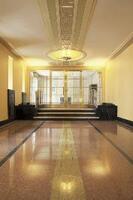HABITAT
Salvaging Original Fixtures
Oct. 21, 2009 — Say "pre-war" anywhere else in the world, and you'll get everything from a wistful nostalgia to a desperate longing for an end to atrocity. Say it in New York City, and it's all about the real estate. Buyers covet pre-war apartment houses — those built in the several decades preceding World War II — for their architectural details and rock-solid construction. Yet the "pre-war" part doesn't usually extend to interiors, where renovations ranging from efficacious to "ecch" often turn apartments into boxes.
Now, however, some boards are salvaging treasures and giving them to shareholders, who find themselves getting beautiful etched-glass mirrors, vintage 1930s bathroom sinks and much more — for free. Apartment-owners save money on fixtures, while the elegant antiques increase units' values — in turn increasing value for fellow owners.
Two such programs demonstrate how this surprisingly simple board initiative works. One is at the famed co-op aparment house The Dakota. The other is at 250 Cabrini Blvd. (see lobby interior, above), in the Hudson Heights section of northern Manhattan, at W. 187th Street – a middle-class enclave where shareholders aren't rich, yet live in Art Deco glamor.
"We've saved things from doors to doorknobs," says shareholder Kate Wood, who with her husband David Sprouls administers the program at 250 Cabrini. "It's amazing how much buildings have in them that's unique," she says. Any shareholder can donate their apartment's original fixtures to the program, and any shareholder can take from the inventory.
The board-approved program has been successful both for architectural and environmental reasons, Wood says. "I think people kind of get it now. They're thinking more in terms of being green and of sustainability. And," she adds lightly, "there's a little bit of a guilt factor. Here's something that's survived 80 years and are you're just going to throw it out on the sidewalk?"
Any shareholder can donate their
original fixtures, and any shareholder
can take from the inventory.
The program began four years ago, she says, a year after she and her husband had bought into 250 Cabrini. The 1937 building had been designed by Russell M. Boak and Hyman F. Paris, who 10 years earlier had formed their own company after working for the famed architect Emery Roth. Other Boak & Paris buildings include 315 Riverside Drive, at W. 104th Street; the pink-and-black terra cotta movie house last known as the Metro Theater, landmarked in 1989, on Broadway between 99th and 100th Streets; and the big apartment house on the northeast corner of Broadway and 106th Street, which had housed a bank and now a Duane Reade pharmacy on the first floor.
When Wood, the executive director of the preservation-advocacy group Landmark West!, and Sprouls moved in, they appreciated that "our apartment has a great sunken living room and a lot of intact details — railings, door knobs, light fixtures — but the kitchen and the bathroom had been kind of Home Depot-ized. The sponsor had done that to sell the apartment as renovated." Later, seeing some of the original, unrenovated apartments, "We thought, 'Wouldn't it be a waste to throw away these great old sinks, these details, those mirrors.'"
Wood, through her job, was familiar with The Dakota's salvage program, and she and her husband convinced the board to let them begin a similar program here. "We sent out a notice that if you are renovating, we will store your old fixtures in case someone else who's renovating would like to reincorporate those features. There seems to be very positive response. I get phone calls, not every day, but people have bought into the idea that it's a good program to have."
The co-op newsletter keeps shareholders up to date on what's available. One recent edition listed among its items an original Kohler chrome sink with taps and faucets, a medicine cabinet with etched-glass mirror, laundry hampers, a wooden interior door with the wood door with the original hardware, and even a bathtub.
The inventory is stored in a room on the roof, attached to the bulkhead for the elevator. Only Wood and the super have keys. The mostly porcelain, metal and glass fixtures aren't sensitive to temperature, and anything breakable is wrapped and labeled. The room itself "is a designated space; nothing else can be stored there. No paint cans, no workers going in and out." Wood and Sproul keep track of inventory, and the co-op's managing agent knows to inform shareholders and potential buyers about the program.




